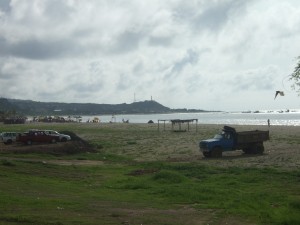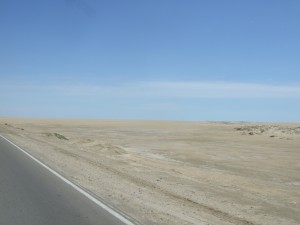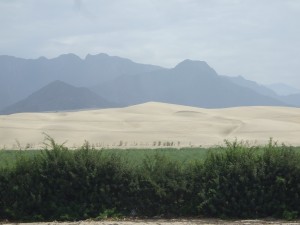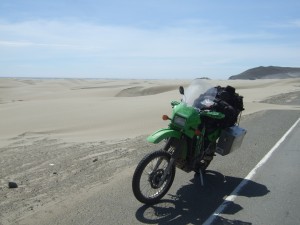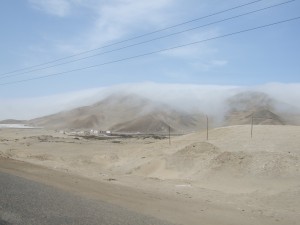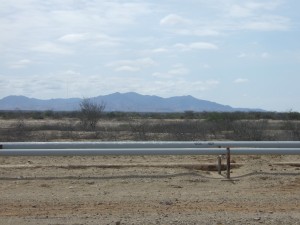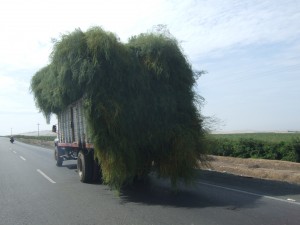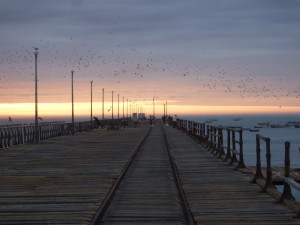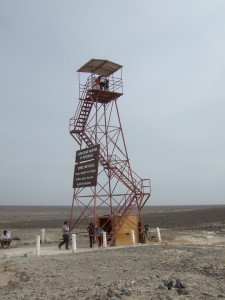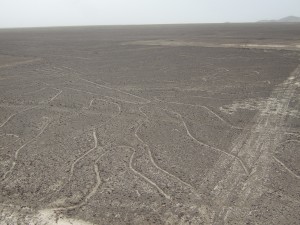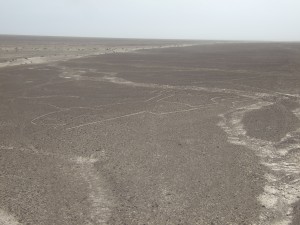Western Peru
Entering Peru was a throwback to Central America, though thankfully without the unnecessary fees. Customs was directly across the bridge into Peru, three kilometers before Immigration, and was simply a shack with a couple old Peruvians sitting outside flagging down suspect looking vehicles. Our Colombian adventure-rider friend Oscar had advised us to come with photocopies so we didn’t need to go looking for them at the border, and though we made sure we copies of all the information we had that we could potentially need, that didn’t stop them from demanding a copy of the exit stamp from Ecuador, which we couldn’t possibly have made in advance. They directed me with a hand wave into the town to find a copy machine, and then I was in the thick of one of the densest and strangest border towns to date.
Hundreds of people milled across the border, dragging shopping bags, riding bikes, and selling things from carts. Joe’s tall white self had become an instant celebrity standing at our two giant loaded bikes, and had the job of trying to understand and answer the barrage of questions curious passersby may have, and of course pose for the occasional picture. In the heat of the mid-day sun – though equipped with my Ecuadoran hat – I ventured through the streets in search of an elusive photocopier. For some reason, Peru seems to be a sort of shopping Mecca for Ecuadorans, who perhaps suffer from less popular ports of higher tariffs, as directly across the border was a massive shopping center packed with endless allies of clothes shops. I even saw multiple stores selling mannequins within a block of one another! I asked dozens of people where to find a photocopier, and was bounced around the endless shopping walkways for more than a half hour with no luck. Being a Sunday, many of the copy shops were shut down, while others had broken machines or simply advertised making copies but didn’t even have a copying machine. I eventually found one that worked, and had copies made using some of the small bit of Peruvian money my Dad changed at the border, which we got a miraculous exchange rate of 3.3 Peruvian Nuevos Soles to the USD, whereas we’d been offered 3.1 by other money changers. For those of you out there who invested with Allen Stanford, please hold your advice till later.
Returning with the photocopies, I then had the great honor of filling out by hand in crazy small print to fit the forms, in duplicate, all the information for both bikes while the fat Peruvian customs agent glowered at me, obvious a big fan of his own job. While I was filling out paperwork, an Irish adventure rider on a 650 Suzuki V-Strom named Pat showed up and talked to my Dad. When I emerged, we waded through the crowded retail machinery and insane motorcycle taxi cabs, stopping once to get money at the ATM about a kilometer after the border that the money changers insisted didn’t exist. Immigration was thankfully easy to find, and after filling out the silly card, went through pretty quickly, but couldn’t do my Dad’s as well (which sometimes is the case). After trading places with him a guy in a green vest came up to me and insisted we had to pay for the parking outside the Immigration office, a completely insane notion. I bullshitted with the guy for more than 5 minutes, and re-asked him about the pay-for-parking nonsense, but he held fast, waving his ream of parking stubs and insisting that everyone has to pay. He also insisted we needed to pay for both bikes, at a rate of 3 soles a piece (slightly less than a dollar). I gave him four and told him it was for both bikes, which he agreed to and gave me one parking permit. Not long after my Dad returned and we hit the great western Peruvian highway.
And what a highway! I’d had several people tell me that the roads in Peru were the best in South America, and I was quickly inclined to believe them. Wide, freshly painted, completely devoid of potholes, with tons of signs, and graceful curves through the mountains, it was a beautiful thing for a pair of eyes that has seen the carnage our bikes have had to endure on this trip. Still in awe of the road, it brought us back to the Pacific Ocean, glistening and cerulean in the baking southern sun.
We stopped for a couple Peruvian beers and a massive plate of amazing ceviche, feeling the cool ocean breeze and breathing the fresh salty air. While we were getting back on the bikes, Pat from the border went by us, and when we caught up and passed him, he came into formation with us and began riding with us. Less than a mile later while I was in the lead, two dogs ran onto the highway, and the car in front of me smashed into the second at highway speeds, sending it sliding and spinning down the road and into the opposing lane. We’ve seen plenty of roadkill along our path, and with Joe’s cow incident, even another vehicle-on-animal accident, but there was something about how the dying dog’s companion stopped running and watched it skid to a twitching stop that I don’t know if I’ll ever quite get out of my mind.
Before long, the road curved back away from the ocean and beach, and dropped us in a vast and desolate desert. Because of my previous trip to Peru, I had a set of expectations for the terrain, the only type of which I’d seen before being jungle. To be sure, I had not expected the entire west coast of the place to be desolate wind-swept desert. I guess I stand corrected, huh?
I’ve been through what seems like an awful lot of desert before, criss-crossing the American southwest on numerous occasions, driving down Baja California, and cutting through a fair bit of the stuff in Mexico on this trip, but I’ve never seen anything like what I saw in western Peru. The sheer variation in it is still hard for me to wrap my mind around. There are parts that looks positively Saharan, with massive light brown sand dunes stretching absolutely as far as the eye can see, massive dark rocky mountains with light sand seeming to run down in rivulets, stretches of sand completely flat as far as the as the eye can see (which is a considerable distance in the desert) in every direction, parts somehow cultivated into fields in reclaimed land surrounded on all sides by arid wasteland, sand in every color of the rainbow, desert pushing right into the Pacific ocean complete with a cool ocean breeze, and even desert covered in fog!
But I’m getting ahead of myself. Our first stint was in the oil lands, that is to say desert covered in derricks and pipelines.
And in this thoroughly Mad Max landscape, we were passed by several caravans of the most post-apocalyptic trucks imaginable: big ghastly iron semi-trucks with no cabs or smoke stacks. The driver sat on presumably the only chair, sometimes behind a piece of glass fastened between two boards, but often entirely in the elements, wearing goggles and a hat. They flew by, engines exposed, blue tarps flapping around undiscernible machinery, no visible cargo in tow, occasionally one lit headlight, abominations of motor vehicles and a wonder that more than one exists and runs. Man do I wish I’d managed to get them on camera!
We ended the day with some time to spare in the beach town of Máncora, and with our new friend Pat, found a room with 4 beds (one was a bunk so we used the top for storage) at a place with a poo, a bar, and wireless internet for about $6.50 per person. We swam in the pool, caught up on email, and swapped stories with Pat. Turns out the guy’s on a trip around the world, starting in Florida, on his way to Santiago, then flying to and crossing Australia, then flying to southeast Asia, then Europe again. If that didn’t make us feel inferior enough, he used his trip to raise a huge amount of money to help start Hospice in Ireland. Plus the guy’s a ton of fun.
The next morning, we had a leisurely breakfast and hit the desert in the late morning. Riding in our new 3-bike formation, we made great time through miles and miles of desert, often butted against the pacific, which helped vary the temperature between 110 and 60, but always with the sun beating down upon us unobstructed. We passed tons of cops, the most per mile yet, along the side of the road pulling over cars, and as seems to be our trend in South America, we saw cars in front of and behind us be pulled over, but were never bothered. The road was completely pothole free, mostly well labeled, and had only light traffic. We passed hundreds of “Zona Urbana” signs in the desert, but saw little of what I’d call urban zones, which helped us make fantastic time down the coast.
As the sunlight waned, we decided on the town of Pacasmayo as a reasonable place to stop for the night. The first welcoming sight as entered the town was a massive, ugly cement factory. A coastal town, we crossed our fingers that things may get better as we moved towards the ocean. We found a bustling coastal town with a fair bit of charm, and found a couple rooms at a brand new hotel. So new that while checking in, they were running my mattress up the stairs and assembling my bed. We moved in and found dinner at a packed chicken chicken restaurant and I had a strawberry shake.
Halfway through the night in the brand new bed, I woke up with horrible cramps and a bad stomach ache. I managed to get back to sleep, but woke up in the morning feeling even worse, and sporting a fever. It was clearly a case of food poisoning, and I’d eaten exactly the same set of things as Pat and Joe, save the strawberry milkshake. I gotta say, the milkshake was so not worth it.
We’d had big plans to get up early and get to Lima before the end of the day, but I was in no shape to move. I went to our complimentary breakfast, and promptly threw it up. Pat gave me some medicine for the cramps, which helped a little, but still whenever I got up, I felt awful. So instead I stayed in bed nearly all day sleeping, working on this blog, or completely vegging out to crappy movies with Spanish commercials. Joe and Pat went out exploring in town, and found it had a packed beach, huge pier, and some picturesque landscape. I made up my mind to make it out of the hotel room at least once in the day, so I schlepped my sick frame up to the beach for the sunset, and paid a Peruvian Neuvo Sol ($0.30) to go out on the pier. In the USA, the pier would have been condemned and you could be arrested for being out on it, in Peru they charge you for the priviledge of risking your life on the nearly kilometer long wooden pier, planks loose, missing, and rotting to pieces. Guard rails? Peruvians don’t need guard rails.
We had dinner at a hotel restaurant on the beach, where I indulged in a couple pieces of bread and some tea, and happily kept it down. We called it an early night in hopes of trying our luck at an early start again. We were at breakfast at 7am, and Pat had worked his magic with the receptionist to score us an upgrade to eggs with our complimentary breakfast, but of course, there was a massive table of Peruvian women who were also staying at the hotel, and they all got eggs too. Go figure.
No trouble getting out of Pacasmayo, and we were making great time except one little cavaet: Joe’s bike, which had been having an issue with not drawing fuel from reserve for ages, suddenly started having more fuel problems, and before long, it was only making it 100 miles on a tank of gas, at which point he’d put our gas can into his bike and make it far enough to get to a gas station and fill up again. As our money supplies dwindled, the 100 Nuevo Soles bill that my Dad had gotten from the money changer at the border, and which had been in the back of his wallet, finally made its appearance at a gas station, where the attendants insisted it was fake. They showed us all the ways you could tell, all of which seemed like some sort of voodoo magic: rub your fingers over these two spots, look at the shade of purple on the 100, etc. The bill was utterly convincing to the untrained eye, even having a watermark and, we later found out, blacklight sensitive ink with the number. We tried it a few times and every gas station caught the fake, and finally one attendant showed that if you crumpled the bill up, it straightened out with tears, unlike the real bills. Damn. That 3.3 exchange rate really was too good to be true.
Doing the frequent gas station dance, we made it to Lima with sunlight to spare. Traffic quickly changed from nonexistant to furious. Miles from the city proper, the road turned into a four, then six,-lane divided highway, with aggressive Peruvian drivers at their worst. Lima unfolded before us like a bad movie, with each minute of ugly cinderblock landscape, streets covered in blowing trash, and drivers all but running us off the road making us wonder why we didn’t read the reviews on Rotten Tomatoes and skip this one, and now that we were committed, all we could think about is when it would end. Sorry Lima, you’re no Slumdog Millionaire.
We finally got off the main drag in a quaint little neighborhood called Los Olivos that showed what a difference a few blocks could make, as things became markedly less seedy. We found a couple hotels, and thanks to having the best Spanish skills, I was in charge of checking them out. The second offered us a pretty decent deal and included parking, so we went for it… Except when I brought Joe and Pat to the garage and the people saw our bikes, they decided they could tack on the Gringo Tax, and insisted it would be more. Thoroughly uninterested in searching further, we took the place regardless. We then hit the area looking for food and found an Argentinian steak house right around the corner, the chef, an extremely friendly Argentinian, cooking amazing looking steaks on a grill on the sidewalk. We got the chef’s recommendation, and thoroughly gorged ourselves on amazingly cooked slabs of steak with salad and potatoes. It cost about $3.50 per person.
The next morning, Pat headed off in search of a tire, and we went to breakfast, where we looked through the yellow pages for options for our own bikes. When we came back to the hotel, the receptionist insisted we owed more money because we’d only paid for the night, and that we were supposed to be out at 6am unless we paid for the day. Plus we owed more money if we wanted to stay an additional night! Completely frustrated, we decided to leave right then, deciding we could wait on the tires till Santiago or La Paz, left Pat a note, and got back on the Panamerican out of Lima.
Traffic was terrible the first half of the ride. It was blazingly hot, large trucks and buses spewed choking black smoke all over the roadway and garbage flew like in a cartoon windstorm. After the north-south highway we were on intersected the east-west highway that led to the city’s centro, traffic died way down, and we actually started making time. Our highway met back up with the ocean just as Lima proper ends, and left us on a road through dozens of small little beach towns that exist as vacation spots for Limans. Blocking out much of the endless expanse of desert flanking the resort towns were a string of the most sophisticated and expensive billboard advertisements I’ve ever seen. These things were massive, 3-dimensional, and fancy as all hell. There was one for a popsicle brand that actually covered the top of a mountain with fake snow running down from the billboard.
We found a hotel in the surfing town of San Bartolo, and got to the messy business of changing our oil, the other task we’d given ourselves in Lima. We also removed the inline fuel filter we thought may be causing my Dad’s bike to not use all its fuel. Afterwards we walked our oil-covered selves to the beach, a beautiful cove with big curling waves packed with surfers, and more beach front restaurant than you can shake a stick at. We got suitably covered in salt, came home and showered, and had one last meal of ceviche before we left the coast.
The next day, the road curved away from the ocean and headed towards the town of Nasca, our turn-off out of the desert and towards Machu Picchu. Despite the removed fuel filter, Joe’s bike continued to stumble, and eventually with nearly a full tank, it quit in the most godawful place possible: a vast rocky plain, with strong constant wind blowing sand at us. In a last ditch effort, my Dad removed the fuel line from the tank and sucked fuel back out from the carb in an attempt to clear it of potential blockage, and miraculously, at the price of a mouthful of gas, the problem was finally fixed. Miles of more desert brought us through the town of Pisco, assumedly where the grape brandy gets its name, and suddenly every town was full of stores selling wine and Pisco.
While driving through more windy rocky desert, we spotted a private plane doing slow, repeated passes over the valley, and finally came up on an observation tower on the side of the road.
Not up on my Peruvian archeology, Nasca is home to the Nasca Lines, giant ancient line drawings made in the barren rocky desert thousands of years ago. We climbed the tower (1 Nuevo Sol) which affords a view of two of the drawings, a tree and a bird:
There are apparently a lot more of the drawings out in the desert, but they’re only visible by air, and a plane ride sets you back about $55 per person, which was more than it was worth to us. And don’t try going exploring on your own, because the Peruvian government has been kind enough to landmine the desert to keep people from erasing the lines. How lovely!
When we made it to Nasca proper, while stopped and discussing where we’d stay for the night, a woman in a car pulled over and handed me a flier for one of her hotels. It was obviously fancy and beyond our price range. When we made that clear to her, she said she had 2 others, and could give us one for 40 Nuevo Soles (like $13), so we followed her a couple blocks off the main drag and checked the place out. The place had real hot water, a balcony overlooking the street, and they let us park our motorcycles inside the hotel (like literally in the lobby). Plus it included breakfast and time on the internet on their computers. It had to be one of the best deals we’ve had yet.
Aside from hosting the lines, Nasca is a big tourist staging ground for buses to Machu Picchu and Arequipa, two big tourist spots, and the town oozes tourism. But February is one of the slowest months here for tourists, and so waiters were in the streets outside their restaurants, waving menus and trying to get the few wandering gringos in. We had dinner at one of the few places not hawking on the street, and with the most reasonable prices in town. Afterwards, I tried to check out the night life, which was nearly nonexistant, but I did manage to get an absolutely amazing Pisco sour.
Nasca marked the end of our stint in the desert of Western Peru. The next day, we’d climb back into the mountains and head for Cuzco, where you can catch the train to Machu Picchu!

